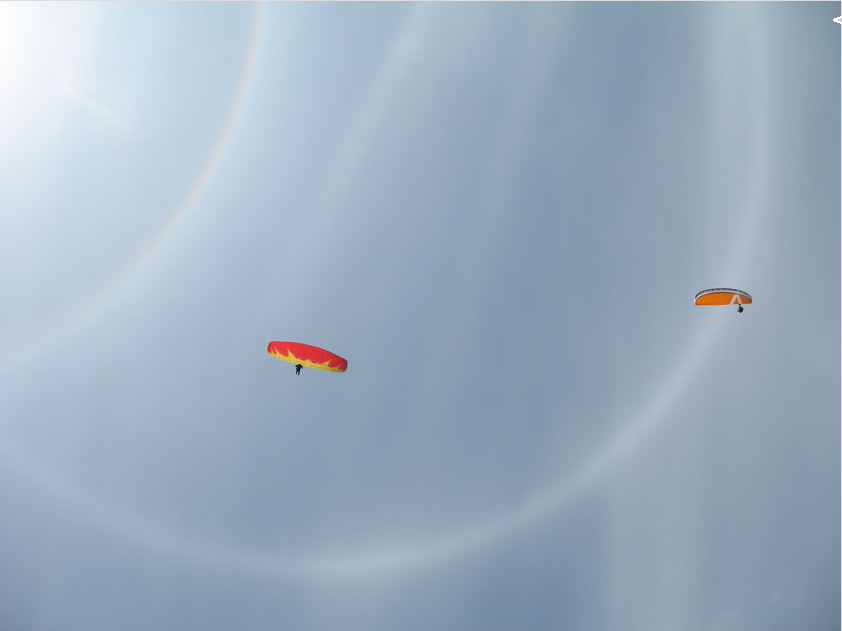Paragliders and parhelic circle
Paragliders and the Enigmatic Parhelic Circle
When it comes to atmospheric optics, one phenomenon that captivates both scientists and nature enthusiasts alike is the parhelic circle. This celestial display, often observed in the presence of thin cirrus haze, forms a stunning backdrop for various elements of the sky. In this article, we will delve into the intriguing connection between paragliders and the enigmatic parhelic circle, shedding light on their interaction and the awe-inspiring visuals they create.
The parhelic circle, also known as the circumzenithal arc, is a circular band of light that appears at a specific angle from the sun. It occurs when sunlight interacts with ice crystals in the atmosphere, causing the light to refract and create a multitude of colors. This mesmerizing optical phenomenon can be seen as a complete or partial circle, depending on the position of the observer and the orientation of the ice crystals.
In the captivating image captured by Andrew Pugh at Bridal Falls, Chilliwack, British Columbia, we are presented with a breathtaking scene where two paragliders gracefully soar through the sky. Against the backdrop of a high sun parhelic circle, their presence adds an element of dynamism and wonder to the composition. The parhelic circle appears as a circular arc at the top left, while another halo-like phenomenon, known as the 22° halo, can be seen near the 59° high sun.
To fully appreciate the beauty of this image, it is essential to understand how paragliders interact with the parhelic circle. As paragliders ascend into the sky, they navigate through the same atmospheric conditions that give rise to the parhelic circle. The ice crystals suspended in the air create a dazzling display of light around the paragliders, amplifying their ethereal presence against the backdrop of the sky.
The parhelic circle is an optical phenomenon that occurs when sunlight passes through hexagonal ice crystals in the atmosphere. These ice crystals act as tiny prisms, bending and refracting the light, resulting in the formation of the parhelic circle. This circular band of light appears at an angle of approximately 22 degrees from the sun and is often accompanied by other atmospheric phenomena such as halos and sundogs.
The parhelic circle is best observed when the sun is relatively high in the sky, typically around midday. In this position, the sunlight has a shorter path to travel through the atmosphere, allowing for a greater concentration of ice crystals to interact with the light. When combined with the presence of thin cirrus haze, which provides a canvas for the display, the parhelic circle becomes a captivating spectacle that enchants both casual observers and seasoned skywatchers.
As the paragliders soar through the sky, their movements intersect with the path of the parhelic circle, creating a mesmerizing visual experience. The parhelic circle acts as a celestial halo around the paragliders, enhancing their ethereal presence and making them appear almost otherworldly. This harmonious interaction between the parhelic circle and the paragliders serves as a reminder of the interconnectedness of nature and the beauty that can be found in unexpected encounters.
In conclusion, the connection between paragliders and the enigmatic parhelic circle offers a captivating glimpse into the world of atmospheric optics. As these skilled pilots navigate through the same atmospheric conditions that give rise to this celestial display, they become an integral part of the visual symphony unfolding in the sky. The image captured by Andrew Pugh beautifully showcases this interaction, where paragliders gracefully soar against the backdrop of a high sun parhelic circle. It is through these encounters that we are reminded of the awe-inspiring wonders that nature has to offer and the infinite possibilities that await those who dare to explore the skies.

High sun parhelic circle in thin cirrus haze forms a backdrop for two paragliders.
The coloured arcs at top left and near the 59° high sun are a 22° and circumscribed halo.
The camera is pointing upwards towards the zenith and centre of the parhelic circle.
Imaged by Andrew Pugh at Bridal Falls, Chilliwack, British Columbia July 7, '07.
Image ©Andrew Pugh, shown with permission.
Note: this article has been automatically converted from the old site and may not appear as intended. You can find the original article here.
Reference Atmospheric Optics
If you use any of the definitions, information, or data presented on Atmospheric Optics, please copy the link or reference below to properly credit us as the reference source. Thank you!
-
<a href="https://atoptics.co.uk/blog/paragliders-and-parhelic-circle/">Paragliders and parhelic circle</a>
-
"Paragliders and parhelic circle". Atmospheric Optics. Accessed on April 18, 2024. https://atoptics.co.uk/blog/paragliders-and-parhelic-circle/.
-
"Paragliders and parhelic circle". Atmospheric Optics, https://atoptics.co.uk/blog/paragliders-and-parhelic-circle/. Accessed 18 April, 2024
-
Paragliders and parhelic circle. Atmospheric Optics. Retrieved from https://atoptics.co.uk/blog/paragliders-and-parhelic-circle/.